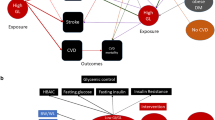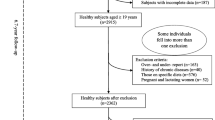Abstract
Hyperglycemia and hyperinsulinemia are central features of the metabolic syndrome and type 2 diabetes mellitus, which contribute to the pathogenesis of coronary heart disease (CHD). Recent data indicate that increased dietary glycemic load (GL) due to replacing fats with carbohydrates or increasing intake of rapidly absorbed carbohydrates (ie, high glycemic index [GI]) can create a self-perpetuating insulin resistance state and predicts greater CHD risk. In this paper, we discuss the historic development of the GI and GL concepts and summarize metabolic experiments and epidemiologic observations relating to clinical utilities of these measures. On balance, increased consumption of low-GI foods leads to improvements in glycemia and dyslipidemia in metabolic studies, and a low-GL diet has been associated with lower risk of type 2 diabetes and CHD in prospective cohort studies. We conclude that decreasing dietary GL by reducing the intake of high-glycemic beverages and replacing refined grain products and potatoes with minimally processed plant-based foods such as whole grains, fruits, and vegetables may reduce CHD incidence in sedentary individuals and populations with a high prevalence of overweight. Because of advances in food-processing technologies and changes in ingredients in our food supply, the composition and physiologic effects of foods are likely to change over time. Future efforts should continue to quantify and monitor the metabolic impacts of different foods, and such information should be routinely incorporated into long-term prospective studies to allow for the assessment of the interactive effects of diets and other metabolic determinants on chronic disease risk.
Similar content being viewed by others
References and Recommended Reading
Decline in deaths from heart disease and stroke—United States, 1900–1999.MMWR 1999, 48:649–656.
Harris MI, Flegal KM, Cowie CC, et al.: Prevalence of diabetes, impaired fasting glucose, and impaired glucose tolerance in U.S. adults. The Third National Health and Nutrition Examination Survey, 1988–1994. Diabetes Care 1998, 21:518–524.
Stephen AM, Wald NJ: Trends in individual consumption of dietary fat in the United States, 1920–1984. Am J Clin Nutr 1990, 52:457–469.
Reaven GM: Do high carbohydrate diets prevent the development or attenuate the manifestations (or both) of syndrome X? A viewpoint strongly against. Curr Opin Lipidol 1997, 8:23–27.
Willett W: Dietary fat plays a major role in obesity: no. Obes Rev 2002, 3:59–68.
Liu S, Manson J: Dietary carbohydrates, physical activity, obesity, and the ‘metabolic syndrome’ as predictors of coronary heart disease. Curr Opin Lipidol 2001, 12:395–404.
Ludwig DS: The glycemic index: physiological mechanisms relating to obesity, diabetes, and cardiovascular disease. JAMA 2002, 287:2414–2423.
Willett W, Manson J, Liu S: Glycemic index, glycemic load, and risk of type 2 diabetes. Am J Clin Nutr 2002, 76:274S-280S.
Brand-Miller JC, Holt SH, Pawlak DB, McMillan J: Glycemic index and obesity. Am J Clin Nutr 2002, 76:281S-285S.
Bantle J: Clinical aspects of sucrose and fructose metabolism. Diabetes Care 1984, 12:56–61.
Daly M, Vale C, Walker M, Alberti K, Mathers J: Dietary carbohydrates and insulin sensitivity: a review of the evidence and clinical implication. Am J Clin Nutr 1997, 66:1072–1085.
Crapo PA, Reaven G, Olefsky J: Plasma glucose and insulin responses to orally administered simple and complex carbohydrates. Diabetes 1976, 25:741–747.
Crapo PA, Reaven GM, Olefsky J: Post-prandial plasma-glucose and insulin responses to different complex carbohydrates. Diabetes 1977, 26:1178–1183.
Jenkins DJ, Wolever TM, Taylor RH, et al.: Glycemic index of foods: a physiological basis for carbohydrate exchange. Am J Clin Nutr 1981, 34:362–366.
Jenkins DJ, Jenkins AL, Wolever TM: Low glycemic index: lente carbohydrates and physiological effects of altered food frequency. Am J Clin Nutr 1994, 59:706S-709S.
Wolever TM, Bolognesi C: Prediction of glucose and insulin responses of normal subjects after consuming mixed meals varying in energy, protein, fat, carbohydrate and glycemic index. J Nutr 1996, 126:2807–2812.
Wolever T, Bolognesi C: Prediction of glucose and insulin responses of normal subjects after consuming mixed meals varying in energy, protein, fat, carbohydrate and glycemic index. Nutrition 1992, 126:2807–2812.
Foster-Powell K, Holt SH, Brand-Miller JC: International table of glycemic index and glycemic load values: 2002. Am J Clin Nutr 2002, 76:5–56.
Coulston AM, Hollenbeck CB, Liu GC, et al.: Effect of source of dietary carbohydrate on plasma glucose, insulin, and gastric inhibitory polypeptide responses to test meals in subjects with noninsulin-dependent diabetes mellitus. Am J Clin Nutr 1984, 40:965–970.
Crapo PA, Olefsky JM: Food fallacies and blood sugar. N Engl J Med 1983, 309:44–45.
Hollenbeck C, Coulston A, Reaven G: Glycemic effects of carbohydrates: a different perspective. Diabetes Care 1986, 9:641–647.
Wolever TM, Jenkins DJ, Jenkins AL, Josse RG: The glycemic index: methodology and clinical implications. Am J Clin Nutr 1991, 54:846–854.
Wolever TM: Relationship between dietary fiber content and composition in foods and the glycemic index. Am J Clin Nutr 1990, 51:72–75.
Jenkins DJ, Josse RG, Jenkins AL, Wolever TM, Vuksan V: Implications of altering the rate of carbohydrate absorption from the gastrointestinal tract. Clin Invest Med 1995, 18:296–302.
Jenkins DJ, Jenkins AL, Wolever TM, et al.: Starchy foods and fiber: reduced rate of digestion and improved carbohydrate metabolism. Scand J Gastroenterol 1987, 129(suppl):132–141.
Wolever TM, Katzman-Relle L, Jenkins AL, et al.: Glycemic index of 102 complex carbohydrate foods in patients with diabetes. Nutr Res 1994, 14:651–669.
Wolever TM, Jenkins DJ: The use of the glycemic index in predicting the blood glucose response to mixed meals. Am J Clin Nutr 1986, 43:167–172.
Liu S: Insulin resistance, hyperglycemia and risk of major chronic diseases—a dietary perspective. Proc Nutr Soc Aust 1998, 22:140–150.
Liu S, Willett WC, Stampfer MJ, et al.: A prospective study of dietary glycemic load, carbohydrate intake and risk of coronary heart disease in US women. Am J Clin Nutr 2000, 71:1455–1461.
Coulston AM, Hollenbeck CB, Reaven GM: Utility of studies measuring glucose and insulin responses to various carbohydrate-containing foods. Am J Clin Nutr 1984, 39:163–167.
Coulston AM, Reaven GM: Much ado about (almost) nothing. Diabetes Care 1997, 20:241–243.
Calle-Pascual AL, Gomez V, Leon E, Bordiu E: Foods with a low glycemic index do not improve glycemic control of both type 1 and type 2 diabetic patients after one month of therapy. Diabetes Metab 1988, 14:629–633.
Hollenbeck C, Coulston A, Reaven G: Comparision of plasma glucose and insulin responses to mixed meals of high-, intermediate- and low-glycemic potential. Diabetes Care 1988, 11:323–329.
Laine DC, Thomas W, Levitt MD, Bantle JP: Comparison of predictive capabilities of diabetic exchange lists and glycemic index of foods. Diabetes Care 1987, 10:387–394.
Coulston AM, Hollenbeck CB, Swislocki AL, Reaven GM: Effect of source of dietary carbohydrate on plasma glucose and insulin responses to mixed meals in subjects with NIDDM. Diabetes Care 1987, 10:395–400.
Diet and exercise in noninsulin-dependent diabetes mellitus. National Institutes of Health Consensus Development Conference Statement.Natl Inst Health Consens Dev Conf Consens Statement 1986, 6:1–7.
Wolever TM, Jenkins DJ: The use of the glycemic index in predicting the blood glucose response to mixed meals. Am J Clin Nutr 1986, 43:167–172.
Wolever T: The glycemic index. In Aspects of Some Vitamins, Minerals and Enzymes in Health and Disease. Edited by Bourne G. Basel, Switzerland: Karger; 1990:120–185.
Brand-Miller J: The importance of glycemic index in diabetes. Am J Clin Nutr 1994, 59(suppl):747S-752S.
Jenkins DJ, Wolever TM, Kalmusky J, et al.: Low glycemic index carbohydrate foods in the management of hyperlipidemia. Am J Clin Nutr 1985, 42:604–617.
Jenkins D, Wolever T, Kalmusky J: Low-glycemic index diet in hyperlipidemia: use of traditional starchy foods. Am J Clin Nutr 1987, 45:66–71.
Dumesnil JG, Turgeon J, Tremblay A, et al.: Effect of a low-glycaemic index—low-fat—high protein diet on the atherogenic metabolic risk profile of abdominally obese men. Br J Nutr 2001, 86:557–568.
Bouche C, Rizkalla SW, Luo J, et al.: Five-week, low-glycemic index diet decreases total fat mass and improves plasma lipid profile in moderately overweight nondiabetic men. Diabetes Care 2002, 25:822–828.
Buyken AE, Toeller M, Heitkamp G, et al.: Glycemic index in the diet of European outpatients with type 1 diabetes: relations to glycated hemoglobin and serum lipids. Am J Clin Nutr 2001, 73:574–581.
Frost G, Leeds AA, Dore CJ, et al.: Glycaemic index as a determinant of serum HDL-cholesterol concentration. Lancet 1999, 353:1045–1048.
Ford E, Liu S: Glycemic index and serum high-density lipoprotein (HDL) cholesterol concentration among United States adults. Arch Intern Med 2001, 161:572–576.
Kahn CR: Insulin action, diabetogenes, and the cause of type II diabetes. Diabetes 1994, 43:1066–1084.
Eriksson J, Franssila-Kallunki A, Ekstrand A, et al.: Early metabolic defects in persons at increased risk for non-insulin- dependent diabetes mellitus. N Engl J Med 1989, 321:337–343.
Haffner S, Stern M, Mitchell B, Hazuda H, Patterson J: Incidence of type II diabetes in Mexican Americans predicted by fasting insulin and glucose levels, obesity, and body-fat distribution. Diabetes 1990, 39:283–288.
DeFronzo R, Bonadonna R, Ferrannini E: Pathogenesis of NIDDM. Diabetes Care 1992, 13:610–630.
Rossetti L, Giaccari A, DeFronzo R: Glucose toxicity. Diabetes Care 1990, 13:610–630.
Leahy JL, Bonner-Weir S, Weir GC: Beta-cell dysfunction induced by chronic hyperglycemia. Current ideas on mechanism of impaired glucose-induced insulin secretion. Diabetes Care 1992, 15:442–455.
Jenkins DJ, Wolever TM, Ocana AM, et al.: Metabolic effects of reducing rate of glucose ingestion by single bolus versus continuous sipping. Diabetes 1990, 39:775–781.
Hu FB, van Dam RM, Liu S: Diet and risk of Type II diabetes: the role of types of fat and carbohydrate. Diabetologia 2001, 44:805–817.
Feskens EJ, Bowles CH, Kromhout D: Carbohydrate intake and body mass index in relation to the risk of glucose intolerance in an elderly population. Am J Clin Nutr 1991, 54:136–140.
Meyer KA, Kushi LH, Jacobs DR Jr, et al.: Carbohydrates, dietary fiber, and incident type 2 diabetes in older women. Am J Clin Nutr 2000, 71:921–930.
Salmeron J, Manson JE, Stampfer MJ, et al.: Dietary fiber, glycemic load, and risk of non-insulin-dependent diabetes mellitus in women. JAMA 1997, 277:472–477.
Salmeron J, Ascherio A, Rimm EB, et al.: Dietary fiber, glycemic load, and risk of NIDDM in men. Diabetes Care 1997, 20:545–550.
Hu FB, Manson JE, Stampfer MJ, et al.: Diet, lifestyle, and the risk of type 2 diabetes mellitus in women. N Engl J Med 2001, 345:790–797.
Jeppesen J, Schaaf P, Jones C, et al.: Effects of low-fat, high-carbohydrate diets on risk factors for ischemic heart disease in postmenopausal women. Am J Clin Nutr 1997, 65:1027–1033.
Brinton EA, Eisenberg S, Breslow JL: Increased apo A-I and apo A-II fractional catabolic rate in patients with low high density lipoprotein-cholesterol levels with or without hypertriglyceridemia. J Clin Invest 1991, 87:536–544.
Abbasi F, McLaughlin T, Lamendola C, et al.: High-carbohydrate diets, triglyceride-rich lipoproteins, and coronary heart disease risk. Am J Cardiol 2000, 85:45–48.
Nestel PJ, Carroll KF, Havenstein N: Plasma triglyceride response to carbohydrates, fats and caloric intake. Metabolism 1970, 19:1–18.
Mancini M, Mattock M, Rabaya E, Chait A, Lewis B: Studies of the mechanisms of carbohydrate-induced lipaemia in normal man. Atherosclerosis 1973, 17:445–454.
Hudgins LC, Seidman CE, Diakun J, Hirsch J: Human fatty acid synthesis is reduced after the substitution of dietary starch for sugar. Am J Clin Nutr 1998, 67:631–639.
Aarsland A, Chinkes D, Wolfe RR: Hepatic and whole-body fat synthesis in humans during carbohydrate overfeeding. Am J Clin Nutr 1997, 65:1774–1782.
Liu S, Manson JE, Stampfer M, et al.: Dietary glycemic load assessed by food frequency questionnaire in relation to plasma high-density lipoprotein cholesterol and fasting triglycerides among postmenopausal women. Am J Clin Nutr 2001, 73:560–566.
Parks EJ, Hellerstein MK: Carbohydrate-induced hypertriacylglycerolemia: historical perspective and review of biological mechanisms. Am J Clin Nutr 2000, 71:412–433.
Sowers JR, Lester MA: Diabetes and cardiovascular disease. Diabetes Care 1999, 22 (suppl 3):C14-C20.
Reaven GM: Banting lecture 1988. Role of insulin resistance in human disease. Diabetes 1988, 37:1595–1607.
Author information
Authors and Affiliations
Rights and permissions
About this article
Cite this article
Liu, S., Willett, W.C. Dietary glycemic load and atherothrombotic risk. Curr Atheroscler Rep 4, 454–461 (2002). https://doi.org/10.1007/s11883-002-0050-2
Issue Date:
DOI: https://doi.org/10.1007/s11883-002-0050-2




